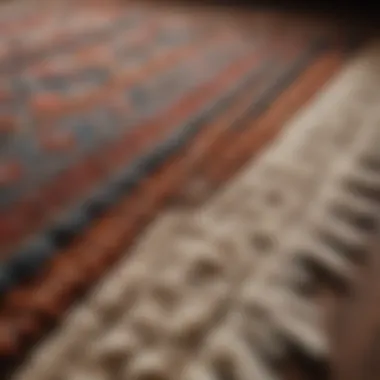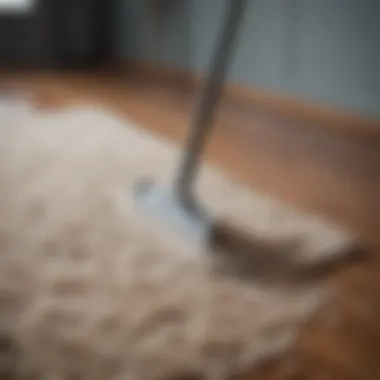Assessing Steam Cleaning for Wool Rugs' Longevity


Intro
Wool rugs are cherished for their warmth and durability. They add an element of comfort to any space, enhancing both aesthetics and functionality. However, they require careful handling when it comes to cleaning. As homeowners and enthusiasts seek effective ways to maintain these valuable textiles, the question arises: Is steam cleaning a safe and effective method for wool rugs? This article will delve into the feasibility of steam cleaning, considering its implications and broader context in rug care.
Key Insights and Trends
In the realm of interior design, maintaining the beauty and integrity of textiles, such as wool rugs, carries significant importance.
Current trends in textile care highlight eco-friendly and efficient methods. Many homeowners are opting for cleaning solutions that do not involve harsh chemicals, leading to a rise in popularity of steam cleaning. Steam cleaning uses high-temperature vapor to lift dirt and grime while disinfecting fibers without the need for added detergents.
However, understanding the specific characteristics of wool is critical. Wool is a natural fiber, known for its elasticity and resilience, but it can be sensitive to both heat and moisture. As such, the choice of cleaning methods directly impacts the rug’s longevity.
- Pros of steam cleaning wool rugs:
- Cons of steam cleaning wool rugs:
- Can effectively remove embedded dirt, allergens, and bacteria.
- Utilizes natural heat, reducing reliance on chemicals.
- Risk of heat damage, leading to shrinkage or felting.
- Potential for excessive moisture, which may foster mildew.
Thus, the ongoing discussion regarding the best methods for cleaning wool rugs remains pertinent for homeowners aiming to preserve their investments.
Practical Tips and How-To Guides
For those considering steam cleaning their wool rugs, several practical tips are essential.
- Test a small area: Before attempting to clean the entire rug, test the steam cleaner on a small, inconspicuous area to ensure the rug does not react negatively.
- Select the right machine: Not all steam cleaners are created equal. Ensure the model is suitable for delicate fibers.
- Adjust settings: Use lower heat settings to prevent damage while still achieving effective cleaning results.
- Limit moisture exposure: Avoid soaking the rug. Instead, focus on using steam briefly and extract as much moisture as possible afterward.
- Follow with air drying: After the cleaning process, let the rug air dry in a well-ventilated space to avoid mildew growth.
"By focusing on proper care, homeowners can maintain the beauty and integrity of their wool rugs for years to come."
Intro to Wool Rugs
Wool rugs represent a unique blend of aesthetic appeal and functional characteristic, making them a favored choice in many homes. Their importance in interior design cannot be overstated. Homeowners, interior design enthusiasts, and party hosts often turn to them for warmth, comfort, and elegance. Understanding the composition and advantages of wool rugs lays the groundwork for exploring their care, particularly in terms of steam cleaning. Wool fibers possess natural properties that contribute to the rugs' durability and beauty. However, proper cleaning methods are essential to protect these qualities over time.
Composition of Wool Rugs
Wool rugs are traditionally made from the fleece of sheep. The type and quality of wool influence the rug's texture, resilience, and appearance. Common wool sources include Merino and Corriedale sheep, known for their fine and soft fibers. Wool has a unique structure that allows it to retain shape and resist bending. The crimp in wool fibers contributes to its insulation properties, making wool rugs not just visually appealing but also functional in maintaining room temperature.
In addition, wool is a naturally occurring fiber that is biodegradable. This ecological advantage aligns with sustainable living practices that some homeowners embrace. Being aware of these composition details helps appreciate the rug's value as an investment in home decor.
Advantages of Using Wool
The advantages of wool rugs are varied and compelling. First and foremost, they are remarkably resilient. Wool fibers can bend and stretch without permanent damage, making them ideal for areas with heavy foot traffic. In addition to durability, wool has a natural stain resistance due to its outer layer's lanolin. This property reduces the likelihood of spills soaking into the fibers.
Moreover, wool rugs are excellent for regulating humidity and air quality. The fibers can absorb moisture, thus contributing to a more comfortable indoor environment. This makes wool rugs an ideal choice for those concerned about air quality in their homes.
Some other key benefits include:


- Insulative Properties: Wool rugs provide warmth in winter while staying cool in summer.
- Noise Reduction: They help absorb sound, adding a more serene atmosphere to living spaces.
- Variety of Designs: Available in a multitude of colors and patterns, wool rugs suit various interior styles.
Understanding Steam Cleaning
Steam cleaning is a method that utilizes vaporized water to clean surfaces and fabrics. This approach has gained popularity in many cleaning kitchens, carpets and even fabrics. Its importance in this article lies in explaining how it interact with wool rugs, which are delicate yet valued for their aesthetics and comfort. Understanding how steam cleaning works can assist homeowners and enthusiasts in evaluating its effectiveness versus other methods.
Mechanism of Steam Cleaning
The basic principle behind steam cleaning involves heating water until it transitions into steam. This steam is then directed onto surfaces, enabling it to lift dirt and debris. The high-temperature steam can penetrate fabrics without soaking them, which is crucial for materials like wool. The steam works by loosening dirt and allergens, making them easier to wipe away.
Some specific elements of the mechanism include:
- High Temperature: The steam produced typically reaches temperatures between 200 to 300 degrees Fahrenheit, which helps in killing germs and dust mites.
- Moisture Control: Unlike traditional methods that soak the material, steam cleaning introduces just enough moisture to cleanse without saturating the rug.
- Chemical-Free: Many steam cleaners do not require detergents, appealing to those concerned about chemical residues.
In summary, understanding this mechanism allows users to appreciate the science behind steam cleaning, especially when considering its application on wool rugs, which are notably sensitive to heat and moisture.
Is Steam Cleaning Suitable for Wool Rugs?
The question of whether steam cleaning is suitable for wool rugs holds significant relevance for homeowners seeking effective cleaning methods. Wool rugs, known for their durability and luxurious feel, require careful cleaning processes to maintain their quality. Thus, investigating the impact of steam cleaning on wool fibers is crucial. This section explores the benefits and potential risks of using steam cleaning as a method for wool rug care, helping to inform the reader’s cleaning decisions.
Benefits of Steam Cleaning Wool Rugs
Steam cleaning offers several advantages when considering the maintenance of wool rugs. First, using steam can provide a deep clean, effectively loosening dirt and debris that may be embedded in the fibers. Steam penetrates the wool, lifting out stains that other methods may fail to tackle. Homeowners appreciate this because it typically does not require the use of harsh chemicals, making it an environmentally-friendly option.
Additionally, steam cleaning can sanitize the rug. The high temperatures involved kill various microorganisms, such as dust mites and bacteria, which can thrive in rugs. For allergy sufferers, this can be particularly beneficial, as it may lead to improved indoor air quality.
Moreover, steam cleaning can be relatively quick compared to traditional methods. Once the cleaning is completed, the drying time may also be reduced if proper ventilation is utilized during and after the cleaning process. Finally, through regular steam cleaning, the overall lifespan of the rug may be extended, preserving the aesthetic appeal and functionality.
Potential Risks Involved
While there are clear benefits to steam cleaning wool rugs, it is also critical to acknowledge the possible risks. Wool is a natural fiber, and its composition makes it susceptible to damage from excessive heat. Using steam that is too hot can cause the fibers to shrink or distort, resulting in a ruined rug. Therefore, controlling the temperature is vital for achieving safe and effective cleaning.
Another concern is moisture retention. Wool fibers can hold water, and when steam cleaning is performed, there is a risk of excessive moisture remaining in the rug. This can lead to mildew or mold growth, which poses health risks and can further damage the rug. Proper drying techniques are essential to mitigate this issue.
Finally, homeowners should consider that while steam cleaning can address larger stains, it might not be as effective for all types of dirt or specific stains. Certain stains, such as oil or wine, may require tailored cleaning solutions that steam may not resolve effectively. In these cases, relying solely on steam cleaning could not only leave unsatisfactory results but also risk making the stain more challenging to remove later.
"Understanding the benefits and risks associated with steam cleaning can ultimately guide homeowners in making informed decisions about their wool rug maintenance."
Homeowners should weigh these advantages and disadvantages carefully. Each rug may respond differently, and factors including rug age, type of wool, and existing damage can affect the outcome of steam cleaning. Assessing these elements will help determine if steam cleaning is indeed a suitable method for maintaining specific wool rugs.
Impact of Heat on Wool Fibers
Understanding the impact of heat on wool fibers is crucial for any homeowner or interior design enthusiast considering steam cleaning their wool rugs. Wool is a natural fiber known for its resilience and thermal properties. However, it is also sensitive to temperature extremes. Excessive heat can alter the structural integrity of wool, leading to damage that may not be immediately visible but could compromise the longevity and appearance of the rug. This section will discuss the effects of excessive heat and moisture retention issues associated with steam cleaning wool rugs.


Effects of Excessive Heat
When wool fibers are exposed to high temperatures, they undergo various changes. One primary concern is the risk of felting. Felting occurs when the scale-like structure of the wool fibers interlocks with each other, resulting in a matted, stiff texture. This effect can occur at temperatures as low as 140°F (60°C).
Regular steam cleaning can subject wool to heat that approaches or exceeds this threshold, especially if proper steam cleaning equipment is not used. Below are some specific effects of heat on wool fibers:
- Loss of Texture: Wool’s natural softness may diminish, leading to a rough surface.
- Color Fading: Intense heat can cause dyes in the wool to fade unevenly, altering the overall appearance of the rug.
- Shape Distortion: Heat can lead to distortion, causing the rug to lose its intended shape over time.
Surveys of wool care practices emphasize the necessity of using a steam cleaner with adjustable temperature settings to avoid exceeding the safe limits for wool fibers.
Moisture Retention Issues
Apart from heat, moisture retention is another concern. Wool is inherently absorbent, allowing it to hold water significantly. This can be beneficial for stain removal; however, combined with steam cleaning, excessive moisture can create a hostile environment for wool. Too much moisture can lead to:
- Mildew and Mold Growth: Leftover moisture can promote the growth of mold, posing health risks and further damaging the rug.
- Increased Drying Time: Wool that becomes overly saturated takes longer to dry, risking felting and shrinkage as it dries.
- Unpleasant Odors: Prolonged moisture can lead to unpleasant smells in the fibers, compounding the impact on the rug’s condition.
Homeowners should take care to ensure that their wool rugs are dried thoroughly after any cleaning, including steam cleaning. Following specific steps for drying can help mitigate these risks.
Alternative Cleaning Methods for Wool Rugs
Wool rugs are not just aesthetically pleasing; they require careful maintenance to preserve their integrity and appearance. With steam cleaning posing certain risks, exploring alternative cleaning methods becomes crucial. Homeowners can benefit from understanding these options, especially regarding safety, effectiveness, and ease of use. Alternative methods can help maintain the rug's quality while ensuring it remains clean and inviting for any gathering.
Dry Cleaning Options
Dry cleaning offers a non-liquid approach to maintaining wool rugs, which can help minimize water exposure that may lead to damage. This method typically uses special solvents or powder cleaners that absorb dirt and contaminants. Here are some key points regarding dry cleaning:
- Less Moisture: As the name suggests, this technique requires minimal moisture. This characteristic is vital for wool fibers, which can be sensitive to water.
- Professional Services: Often, dry cleaning for rugs is best handled by professionals. Their expertise ensures that the right products are used, coupled with efficient techniques.
- Convenience: While it may be less common for homeowners to attempt dry cleaning themselves, many companies offer pick-up and delivery services, making the process hassle-free.
"Dry cleaning can protect your investment. Proper care leads to longer-lasting visual appeal and performance."
Vacuuming Techniques
Regular vacuuming is an essential part of wool rug care. It helps to prevent dirt build-up and extend the life of the fibers. The correct vacuuming techniques can enhance this process considerably:
- Use a Suitable Vacuum: Opt for a vacuum cleaner designed for delicate surfaces. Avoid using beater bars, as they can pull at the fibers.
- Frequency Matters: Vacuuming at least once a week helps to keep dust and allergens at bay. For high-traffic areas, consider increasing the frequency.
- Direction of Vacuuming: Always vacuum along the direction of the fibers. This action minimizes potential damage and keeps the rug looking new.
Spot Cleaning Guidelines
Accidents happen, and knowing how to address them promptly is critical for wool rugs. Spot cleaning involves treating stains as they occur. Here’s how to do it effectively:
- Act Quickly: The sooner you treat a stain, the better the outcome. Use a clean cloth to dab the stain instead of rubbing it.
- Mild Detergents Only: If needed, use a mild detergent mixed with water. Test any cleaning solution on a small, inconspicuous area first to ensure it does not cause damage.
- Rinse and Dry: After treating the area, be sure to rinse with plain water and blot away excess moisture. Allow the area to air dry completely, as trapped moisture can lead to mildew.
By considering these alternative cleaning methods, homeowners can maintain the beauty and integrity of their wool rugs without compromising their quality. Each approach serves a specific purpose and can ensure that your rugs remain in excellent condition.


Expert Recommendations
In navigating the complexities of maintaining wool rugs, expert recommendations play a crucial role. Professionals bring a wealth of knowledge and experience that can help homeowners make informed decisions. They can share insights based on common problems faced in rug maintenance and cleaning. Harnessing expert advice enables homeowners to preserve the quality and longevity of their rugs, especially when considering methods such as steam cleaning.
Consulting Professional Cleaners
Seeking advice from professional cleaners can save time and prevent potential disasters. Professionals can assess the specific characteristics of a wool rug, including its age, weave, and prior treatment. They often have access to specialized tools and cleaning agents designed for delicate materials. Moreover, their experience in identifying common issues like fiber shrinkage or color bleeding is invaluable.
In addition to cleaning, professional cleaners can often recommend proper maintenance routines tailored to each rug. This may include advice on vacuuming techniques, understanding wear patterns, and recognizing the best practices for spot treatments. They might suggest.[1]
- Regular vacuuming schedule
- Use of felt pads under furniture
- Incorporating rug rotation in cleaning routine
By consulting professionals, homeowners can also obtain a better understanding of when to attempt cleaning and when to seek help, especially if they suspect damage could occur from steam cleaning.
Following Manufacturer Guidelines
Adhering to manufacturer guidelines is essential for effective maintenance of wool rugs. Each manufacturer provides detailed care instructions tailored to their products. These guidelines often include specific cleaning methods, recommended products, and precautions necessary to maintain the integrity of the wool fibers. Ignoring these guidelines may lead to unsatisfactory results or damage that might void any warranty.
Typical guidelines may include information on:
- Avoiding harsh chemicals or solvents
- Recommendations for water temperature during cleaning
- Indications for using steam cleaning vs. other methods
Following these directions ensures that the rug receives care best suited to its specific materials and craftsmanship. Homeowners should rinse and test any cleaning product on a small, inconspicuous area first, even if the manufacturer suggests its use. This simple step can prevent larger issues later.
By combining professional insights with manufacturer recommendations, those who own wool rugs can achieve optimal cleanliness without compromising the fabric's beauty. This dual approach is key to preserving wool rugs, which require delicate care.
"Consulting with a pro can illuminate the path to better rug care. Perfect practices stem from informed choices."
For more insights, homeowners might visit notable resources such as Wikipedia and Britannica for fundamental understanding or guidance on specialized rug maintenance.
End
In examining the cleaning methods for wool rugs, it becomes apparent that steam cleaning presents a complex choice. This conclusion synthesizes the various themes covered, aiming to empower homeowners and enthusiasts to make informed decisions regarding the maintenance of their valuable rugs.
Summary of Optimal Cleaning Practices
When it comes to preserving wool rugs, understanding the unique properties of wool is essential. Optimal cleaning practices include:
- Regular Vacuuming: This prevents dirt accumulation. Use a vacuum cleaner without a beater bar to avoid damaging fibers.
- Spot Clean: Tackle stains promptly with a mild detergent mixed in water. Always test on a small, hidden area first to avoid discoloration.
- Professional Dry Cleaning: Consider engaging professional specialists who use non-toxic cleaning methods specifically tailored for wool.
- Avoid Excess Moisture: Excessive moisture can cause issues. Ensure rugs dry completely after cleaning.
All these practices collectively contribute toward safeguarding the integrity of wool rugs while maintaining their aesthetic appeal.
Final Thoughts on Wool Rug Care
Caring for wool rugs requires a nuanced understanding of their materials and suitable cleaning techniques. It is essential to balance cleanliness and preservation; this means weighing the benefits against the potential risks associated with steam cleaning. The knowledge gained from this article equips homeowners and design enthusiasts with the tools needed to maintain their rugs effectively.
As a final reminder, always consider manufacturer recommendations when selecting a cleaning method. This ensures that your beloved wool rugs remain in stellar condition for years to come.



